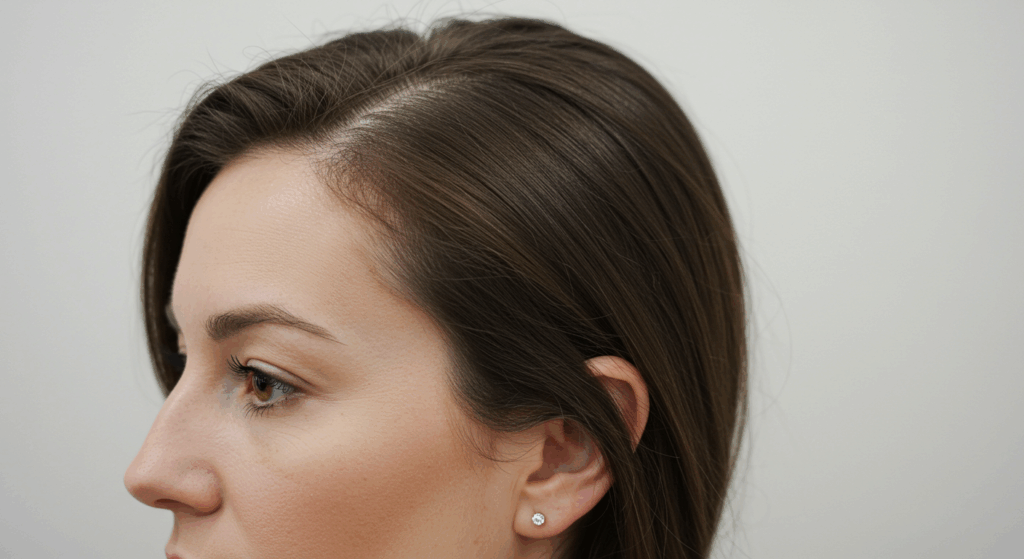For many transgender women and non-binary individuals, facial feminization surgery (FFS) is a pivotal step in aligning physical appearance with gender identity. Among the most transformative procedures is hairline advancement, which reshapes the forehead and hairline to create a softer, more traditionally feminine look. However, like any surgical procedure, it comes with risks, recovery challenges, and critical considerations.
This guide is your comprehensive resource for understanding the risks, recovery timelines, and everything in between for FFS hairline advancement. Whether you’re in the research phase or preparing for surgery, we’ve got you covered.

Table of Contents
What Is FFS Hairline Advancement?
Hairline advancement, also known as forehead reduction or hairline feminization surgery, is a procedure designed to:
- Lower the hairline to reduce forehead height.
- Reshape the hairline to create a more rounded, feminine frame for the face.
- Remove masculine brow bossing (prominent brow ridge).
This procedure is often combined with brow lifts or scalp advancement to achieve optimal results. For a deeper dive into the artistic approaches to hairline alteration, check out our article on Contrasting Approaches to Hairline Alteration in FFS and FMS.
The Risks of FFS Hairline Advancement: What You Need to Know
While hairline advancement can deliver life-changing results, it’s essential to understand the potential risks and complications:
Common Risks
| Risk | Description | Likelihood |
|---|---|---|
| Scarring | Visible scars along the hairline or forehead. Skilled surgeons minimize this risk with precise incision placement. | Low to Moderate |
| Numbness | Temporary or permanent numbness in the forehead or scalp due to nerve damage. | Moderate |
| Hair Loss | Temporary shedding or thinning around the incision site. Rarely, permanent hair loss may occur. | Low |
| Infection | Post-surgical infections are rare but require immediate medical attention if they occur. | Low |
| Asymmetry | Uneven hairline or forehead shape due to healing or surgical technique. | Low |
Rare but Serious Complications
- Hematoma: A collection of blood under the skin that may require drainage.
- Skin Necrosis: Rare but severe complication where tissue dies due to poor blood supply.
- Unsatisfactory Results: Results may not meet expectations, requiring revision surgery.
For more insights on potential complications, explore our detailed guide on FFS Surgery Complications.
Recovery Timeline: What to Expect After Surgery
Recovery from hairline advancement is a gradual process that varies by individual. Below is a week-by-week breakdown of what to expect:
Week 1: Immediate Post-Op Phase
- Days 1-3: Swelling, bruising, and discomfort are common. Pain medication and cold compresses help manage symptoms.
- Days 4-7: Stitches or staples may be removed. Swelling begins to subside, but bruising may persist.
Weeks 2-4: Early Recovery
- Swelling and bruising significantly decrease.
- Numbness or tingling may persist as nerves heal.
- Light activities can be resumed, but strenuous exercise should be avoided.
Weeks 5-12: Intermediate Recovery
- Most swelling resolves, and the hairline begins to settle into its final position.
- Hair may start to regrow around the incision site.
- Follow-up appointments to monitor healing and address any concerns.
Months 3-6: Long-Term Healing
- Final results become apparent as swelling fully subsides.
- Scars continue to fade and mature.
- Full sensation typically returns, though some numbness may persist.
| Timeframe | What to Expect | Tips for Recovery |
|---|---|---|
| Week 1 | Swelling, bruising, discomfort | Rest, cold compresses, prescribed pain medication |
| Weeks 2-4 | Decreased swelling, possible numbness | Avoid strenuous activities, keep incisions clean |
| Weeks 5-12 | Hairline settles, hair regrowth begins | Follow-up appointments, gentle hair care |
| Months 3-6 | Final results, scars fade | Patience, scar care routines |
For more tips on managing recovery, read our guide on Managing Hair Growth After FFS.

Preparing for FFS Hairline Advancement: A Step-by-Step Guide
Proper preparation is key to a smooth surgery and recovery. Here’s how to get ready:
Before Surgery
- Consultation: Discuss your goals, medical history, and expectations with your surgeon. Ask questions like those outlined in our Key FFS Hairline Lowering Questions.
- Medical Evaluation: Complete any required blood tests or health screenings.
- Medication Adjustments: Avoid blood thinners and certain supplements as advised by your surgeon.
- Lifestyle Changes: Quit smoking and limit alcohol to promote healing.
Day of Surgery
- Arrange for a friend or family member to drive you home.
- Wear loose, comfortable clothing.
- Follow pre-op instructions, such as fasting.
Post-Op Essentials
- Stock up on supplies like gauze, cold packs, and prescribed medications.
- Set up a comfortable recovery space with pillows, entertainment, and easy access to essentials.
Frequently Asked Questions (FAQs)
Is hairline advancement painful?
Discomfort is typically manageable with prescribed pain medication. Most patients report mild to moderate pain that subsides within a week.
Will I have visible scars?
Skilled surgeons place incisions along the hairline to minimize visibility. Scars typically fade significantly over time and can be concealed with hair styling.
How soon can I return to work?
Most patients return to work within 1-2 weeks, depending on the nature of their job and healing progress.
Can I combine hairline advancement with other FFS procedures?
Yes! Many patients opt to combine hairline advancement with procedures like brow lifts, rhinoplasty, or jaw contouring for comprehensive facial feminization.
What if I’m unhappy with the results?
Revision surgery is an option if results don’t meet expectations. Open communication with your surgeon is key to achieving your desired outcome.
How do I care for my hair after surgery?
Follow your surgeon’s instructions for washing and styling your hair. Avoid heat styling tools and harsh chemicals until cleared by your surgeon. For more tips, check out our guide on Managing Hair Growth After FFS.
Are there non-surgical alternatives?
Non-surgical options like hair transplants or fillers may offer temporary improvements but typically don’t deliver the same dramatic results as surgery.
What questions should I ask my surgeon?
Prepare a list of questions, such as those in our Key FFS Hairline Lowering Questions guide, to ensure you’re fully informed.
Conclusion: Your Path to Confidence
Key Takeaways
- FFS hairline advancement is a powerful tool for achieving a more feminine appearance.
- Understanding the risks and recovery process is essential for a successful outcome.
- Proper preparation and post-op care can significantly enhance your results.
- Open communication with your surgeon ensures your expectations are aligned with reality.
Next Steps
- Schedule a consultation with a qualified FFS surgeon to discuss your goals.
- Review our FFS Surgery FAQs for more insights.
- Prepare for surgery by following the guidelines outlined in this guide.
Visit Dr.MFO Instagram profile to see real patient transformations! Get a glimpse of the incredible results achieved through facial feminization surgery and other procedures. The profile showcases before-and-after photos that highlight Dr. MFO’s expertise and artistic vision in creating natural-looking, beautiful outcomes.
Ready to take the next step in your journey? Schedule a free consultation with Dr. MFO ( Best Facial Feminization Surgeon for You) today. During the consultation, you can discuss your goals, ask any questions you may have, and learn more about how Dr. MFO can help you achieve your desired look. Don’t hesitate to take advantage of this free opportunity to explore your options and see if Dr. MFO is the right fit for you.









